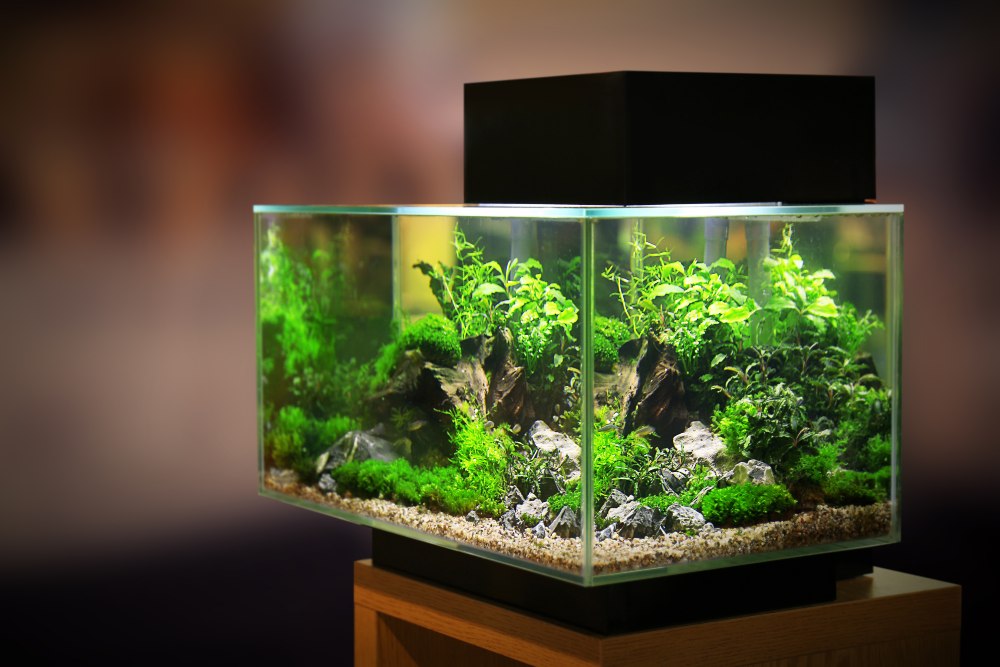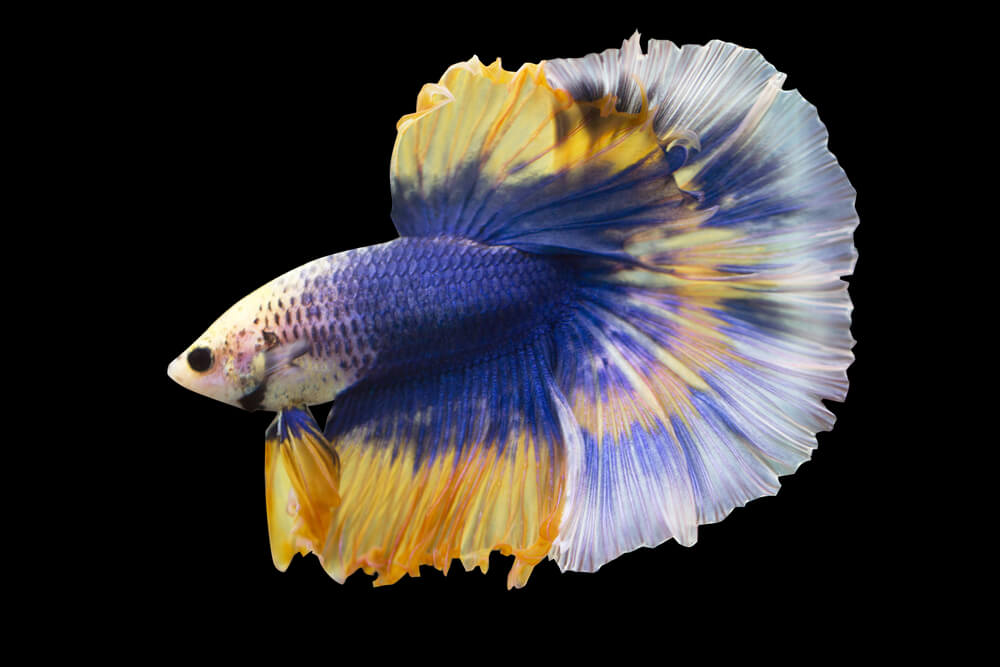The first thing people notice about betta fish is their striking colors and patterns.
This tropical fish, also known as a Siamese fighting fish, is vibrant and beautiful—they’re hard to miss while wandering up and down the aisles of pet stores.
But did you know that when a betta fish is sick, their markings will change, and they’ll develop something known as “betta stress stripes”?
Betta fish might get stressed and develop stress stripes for a variety of reasons, and unfortunately, you might be one of them.
Luckily, stress stripes are easy to recognize, treat, and prevent. The first step is educating yourself, so let’s discover more about the betta fish and why bettas might develop stress stripes. After that, I’ll show you how to treat them.
What are betta fish stress stripes?
First off, what are stress stripes?
Betta fish stress stripes occur when betta fish experience stress or illness.
These stripes are horizontal and appear suddenly on the body of the betta fish. Stress stripes may not appear on the fish’s entire body and can be limited to specific areas such as the tail or fins. They can be seen on both male and female bettas and vary in color from light to dark.
How do stress stripes form?
When a betta fish is stressed, their body releases hormones that trigger the expansion and darkening of melanin cells.
Melanin is responsible for the coloration of a fish’s skin, scales, and fins. As a result, when these cells expand and darken, it creates the appearance of horizontal stripes on the body of the fish.
What causes betta fish stress stripes?
Bettas are prone to stress; luckily, it’s relatively easy to identify what is stressing your betta fish out and help the mheal.
Here are the most common reasons your betta fish might be feeling stressed out:
You’ve recently transferred your betta fish into a new tank
If you’ve recently brought a betta fish home from a pet store, you might notice stress stripes on its body within the first few days.
This is a normal response to the sudden change in environment that the fish has undergone.
However, it’s not typically a serious concern, as the stress stripes should disappear once the fish has had time to settle into its new aquarium.
It’s important to ensure that the tank is set up correctly with adequate filtration, appropriate water conditions, and plenty of hiding places.
The tank is too small

Many first-time betta fish owners make the mistake of keeping their betta fish in a small tank, like a bowl.
If you want to see a happy betta, keep it in a large tank that holds at least 10 gallons of water. The betta fish comes from shallow bodies of water like ponds, so small tanks will make them sick and stressed.
Not enough hiding places

Betta fish thrive in environments that mimic the shallow ponds where they originate. This means that they enjoy having plenty of hiding places and areas where they can play, explore, and swim.
As a betta fish owner, it’s important to provide your fish with a stimulating and comfortable environment that meets their needs.
One way to achieve this is by adding plants to your betta’s tank. Not only do plants help to replicate the natural habitat of bettas, but they also provide endless places for the fish to hide and explore.
Some great plant options for betta tanks include Java ferns, anubias, and marimo moss balls.

These plants not only enhance the aesthetics of your aquarium but also help to maintain water quality and provide oxygen to the water.
It’s important to research the specific plant requirements and ensure they are compatible with your betta’s tank setup before adding them.
Providing your betta with plenty of hiding places and areas to explore will help to reduce stress and promote a happy and healthy environment for your fish!
Your betta fish doesn’t like its tank mates
Although certain fish make great betta tank mates, like guppies, that doesn’t mean all betta fish will like living in a community tank.
Betta fish are known to be solitary creatures and may not enjoy living with other tank mates.
While it’s possible to keep several female betta fish together, it’s not recommended to keep multiple male betta fish together in the same tank. And a male and female betta fish should only be kept together when mating.
Also, when betta fish are stressed, they may become aggressive toward their tank mates, creating an unpleasant and hostile aquarium environment.
When in doubt, keep your betta fish in separate tanks so they don’t become aggressive or stressed.
The water quality is poor
If the aquarium water has accumulated excessive fish waste, uneaten food, or algae, it can significantly impact the betta’s health. These factors contribute to a decrease in water quality and increase harmful chemicals such as ammonia and nitrites.
When these chemicals build up, they can cause the betta’s immune system to weaken, making it susceptible to various diseases and infections.
To maintain a healthy environment for your betta fish, regular water changes and tank cleanings are necessary.
Water changes remove any accumulated waste and harmful chemicals while cleaning the tank helps to control the growth of algae and maintain a balanced ecosystem.
It’s recommended to change 20% of the water in the tank every week to keep your water in check.
The water temperature is wrong or inconsistent
Water temperature is another condition that betta fish are very particular about.
Bettas can survive only in warm water, so you must ensure the tank temperature is always between 75 to 80 degrees Fahrenheit. Any lower and you’ll have a stressed betta fish on your hand.
You should also ensure the tank temperature is consistent and isn’t fluctuating. To keep the water consistent, make sure you have a tank heater that keeps the water at a stable temperature.
Your tank has the wrong water parameters
One critical factor that can cause sudden changes in the betta’s environment is the pH level of the water.
Bettas prefer water with a pH range of 6.8 to 7.5—any fluctuation outside this range can cause stress to the betta, and you may notice the appearance of stress stripes in their body.
If the pH level drops too low or goes too high, it can significantly affect the betta’s health and well-being. A low pH level can cause the water to become too acidic, leading to burns and other skin irritations. On the other hand, a high pH level can cause the water to become too alkaline, leading to fin rot and other bacterial infections.
To ensure that the pH level in the betta tank stays within the recommended range, it’s important to test the water regularly and make any necessary adjustments.
You can also use pH buffering agents to stabilize the water and maintain a healthy and stable environment for your betta fish.
By monitoring the pH level and keeping it within the recommended range, you can help prevent stress and ensure the overall health and well-being of your betta fish.
Your betta is sick
Another reason for betta fish stress stripes is sickness. Bettas are generally active fish, but you’ll notice the fish behavior changing when they get sick, and such changes reflect through stress lines.
Signs of stress stripes to watch for
Aside from the visible stress stripes on your betta fish, there are other indicators that your fish is experiencing stress, such as:
- Rubbing or scratching their body against objects in the aquarium. This behavior can be a result of skin diseases like fin rot, which causes stress and in turn leads to the development of stress stripes.
- If your betta fish is constantly hiding, it could be a sign that they are stressed.
- Loss of appetite is another common symptom of stressed bettas.
- Increased aggression towards other fish is also a sign of a stressed betta.
By paying attention to these signs, you can take action to address the source of your betta fish’s stress and prevent further health issues.
How to prevent betta stress stripes
Regular water changes
One of the common reasons betta fish stress stripes develop is because of dirty tank water.
Changing the water will keep the tank clean and reduce phosphate and nitrate levels.
But make sure you don’t change too much water at once. Such sudden changes will make the betta fish stressed out even more. If you have a filter, change 20% of the water weekly. If you don’t have a filter in your tank, change 30 to 50% water each time. And you should completely clean out your tank every 6-8 months.
Use a water filter
A water filter is the easiest way to maintain water quality. Aquarium filters slow down the development of ammonia and other toxins, keeping the water clean and healthy for the betta’s environment.
I put together a guide on the best tank filters for betta fish to help you pick one for your tank.
Provide good quality food
Providing high-quality and nutritious food will keep the betta happy and prevent stress.
Bettas love eating live foods like bloodworms, brine shrimp, and fish flakes.
A good diet helps build up good immunity, keeping your betta fish healthy and stress-free!
Create a good environment
Bettas need a spacious tank with lots of accessories to interact with. If you are using plastic plants in the tank, replace them with live plants and make sure your betta has lots of places to hide and interact with throughout the day.
Don’t overfeed
Bettas love to eat and will happily chow down on the food you give them, no matter how much you give them.
However, your betta fish won’t just gain weight if you give them too much food. They’ll also get health issues like swim bladder disease.
And if you’re betta fish falls ill, they also have a chance to develop stress stripes. Make sure you’re not overfeeding your betta fish to prevent them from getting sick and stressed.
How to treat betta stress stripes
If your betta fish has developed stress stripes, there are a few things you can try:
Improve their water quality
Poor water quality is often the culprit for stress stripes.
Make sure to test the water in your betta’s tank regularly and keep it within the appropriate pH range of 6.8 to 7.5. You should also do partial water changes frequently to keep the tank clean and remove any excess waste or debris.
Adding live plants to the aquarium can also help improve water quality by absorbing harmful chemicals and providing oxygen for your betta fish to breathe.
Adjust the water temperature
Betta fish are tropical fish and require a warm environment to thrive. If the water temperature in your betta’s tank is too cold or too hot, it can cause stress and lead to stress stripes.
Make sure to keep the water temperature between 75 and 80 degrees Fahrenheit, and use a reliable thermometer to monitor the temperature regularly.
If the temperature is too high or too low, you can adjust it using a heater or fan.
Remove any tank mates
If your betta fish has tank mates and is developing stripes, remove the tank mates and put them in another tank to see if your betta’s stripes improve.
Additionally, make sure to provide plenty of hiding places, such as plants, caves, or decorations, where your betta can retreat for some alone time.
Check for other health issues
If your betta fish has stress stripes, it may indicate other health problems.
Some common health problems that can cause stress stripes include fin rot, parasites, bacterial infections, or a weakened immune system.
If you suspect that your betta has an underlying health problem, it’s important to seek veterinary care immediately.
Your vet can diagnose the problem and recommend an appropriate treatment plan, which may include medications.
Seek veterinary advice
In some cases, your vet may recommend stress-reducing medications to help your betta fish recover from stress stripes. These medications can help calm your betta and reduce stress, allowing them to recover more quickly.
Some common stress-reducing medications for betta fish include aquarium salt, Indian almond leaves, and BettaZing, which contains aloe vera and other natural ingredients to help soothe stressed betta fish.
However, it’s important to only use these medications only under the guidance of your veterinarian.
The difference between stress stripes and breeding stripes
Another common confusion is between betta fish breeding stripes and stress stripes. They are not the same, and breeding stripes are more prominent in female bettas when they are ready to mate, leaving an indication for male bettas.
Breeding stripes run vertically and they are thicker and more prominent. In contrast, stress stripes are horizontal stripes.
Final words
Taking care of betta fish requires a lot of responsibility, especially if you want them to have a longer lifespan. Bettas are known to be very picky when it comes to their tank conditions, and even the slightest change in water quality or tank parameters can cause stress to the fish.
To ensure the well-being of your betta fish, it’s recommended to keep them in a clean and spacious tank with little to no other fish species, as this can help prevent the development of stress stripes.
Have you ever dealt with stress stripes in your betta fish? Tell us your story in the comments below.

